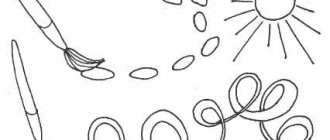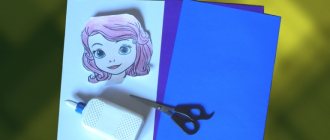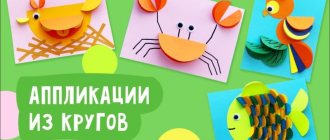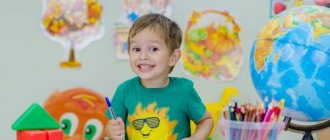Summary of a lesson on application in the first junior group of a preschool educational institution
Lesson summary for the first junior group “Decorating a hat for Mishka.”
Author : Zolotukhna Nadezhda Gennadievna MDOU No. 113 “Gulliver”, Volzhsky. Integration of educational areas : cognitive, artistic and aesthetic. Goal : to develop independent application, learn to put glue on a brush, spread ready-made shapes on oilcloth, use a napkin to remove excess glue. We fix the colors: yellow and red. Cultivate accuracy in work. Material. Hat templates according to the number of children, cut out of white cardboard, yellow circles, red circles, 2 tassels, PVA glue, oilcloth, napkins, Teddy Bear toy. Progress of the game-lesson. Prepare for class by laying out materials and tools on the table. Tell your child that Mishka (sit him on the table) really wants to have a beautiful hat, and invite the child to decorate the hat with red and yellow circles. Fizminutka Where is your hat? Well, look! Get dressed, honey, One, two, and three. Hat, hat It makes your ears warmer. Hat, hat, warm the baby. Where is your hat? It's time to go. Get ready, honey, the kids are waiting for us. Hat, hat It makes your ears warmer. Hat, hat, warm the baby. Glue the first element of the pattern onto your hat, apply glue to the second circle and, guiding the child’s hand, help him stick it on. Then stick a circle and help your baby do the same. Offer to glue the last circle in the pattern to the child yourself. After finishing work, enjoy the beautiful hat with Mishka. Play with her. Say again: “This is a red circle. This is a yellow circle." Even if the baby cannot repeat these words after you, he will definitely remember them. The duration of the lesson is no more than 10 minutes. Organize an exhibition and praise the children!
We recommend watching:
Summary of a game (integrated) lesson on environmental education for the 2nd junior group. A summary of the GCD in the junior group on traffic rules. A synopsis of the GCD on social and communicative development for the 2nd junior group. A synopsis of the GCD for physical education in the second junior group.
Similar articles:
Lesson summary for an early age group. Vegetables: turnips and carrots
Lesson summary for an early age group. Vegetables: beets and potatoes
Lesson summary for an early age group. Fruits: lemon and orange
Lesson summary for an early age group. Cat with kittens
Summary of a lesson in an early age group on a winter theme. Hare and fox
Notes on the topic “Elegant clothing” outline of a lesson on applique, modeling (junior group)
Synopsis “Elegant clothes”
Goal: To strengthen children's skills in using glue
Tasks:
- develop artistic taste during appliqué and evoke a desire to work
- strengthen children's skills in correctly positioning the pattern and using a napkin when making appliqué.
- create a desire to work.
Demonstration material: Dress, shirt, parcel, letter. Handouts: colored paper, glue, dress templates, colored paper sequins.
Progress of the game:
Surprise moment: Teacher: Guys, today we are with you... oh, do you hear someone knocking, so loudly! (The teacher opens the door to no one - there is a package lying there). Guys, we have received a package. Let's see what's there.
Children: Let's go. Educator: Oh, look, what is this? It seems to me that these are some kind of decorations, and there is also a letter here, let's read it.
The teacher reads the letter: “Guys, hello. I need your help. The sewing machines in our studio have broken down, and we can’t make dresses and shirts for our models. Help me please. I sent you jewelry for new clothes in a parcel.
Educator: Well, guys, can we help?
Children: Yes!
Educator: Then let's get to work, now I will distribute materials for making clothes to each of you.
The teacher distributes to the children the materials that were in the parcel (blank dresses, sequins made of colored paper)
Educator: Guys, we will now turn into tailors. We have a lot of work and our arms and legs can get tired. Let's strengthen them with exercises.
Children: Yes!
Phys. minute "Tailor"
Needle, Needle, sew faster - (Children imitate the movement of their hands with a needle when sewing).
We sew clothes for friends. (Clap their hands.)
Matryoshka, teddy bear, Lada doll (count fingers).
Let's dress in new outfits! (They show clothes).
Educator: Well done, you completed all the movements quickly and clearly, and now let’s get started with our dresses. Guys, look how many decorations we have, you can choose the ones you like, and I will show you how you can decorate the dresses. I will apply a drop of glue to my jewelry and apply it to the dress. It's working out great! Now decorate your dresses. (Individual assistance during the decoration of blanks, assistance in choosing colors for a harmonious combination.)
Educator: Guys, just look at what beautiful dresses we made! What is the name of the decoration we used to decorate it with? (Children answer.) Let's make our own clothing exhibition, your dresses and shirts are so beautiful! Let's admire it and then send it to the studio. Now we will place the outfits for the exhibition.
Reflection:
What did you guys like or dislike? What difficulties did you have? How did you figure this out?
Lesson summary on appliqué for the younger group Topic: “Decorating a scarf”
Program content: expand children's knowledge about clothing, enrich children's vocabulary on the topic, cultivate interest in appliqué, consolidate knowledge of colors (red, blue, yellow, green), encourage them to name colors, develop a sense of rhythm, eye
Equipment:
A painting depicting autumn, paper snowflakes, glue, brushes, napkins, a white strip of paper (scarf) for each child
Progress of the lesson:
Finger gymnastics: “Clothes.”
We'll go to the store and find clothes: (fingers walk).
A hat, jacket, scarf, coat and shirt (fold one at a time, starting with the largest one)
We’ll put on a fashionable dress (rhythmic clapping on the knees).
And let's try on all the clothes:
A hat, jacket, scarf, coat and shirt (fold one at a time, starting with the little finger).
Educator: Guys, what time of year is it now? Children's answers.
It's cold outside and you need to wear a jacket, hat, mittens, scarf and boots.
Problematic situation.
“Today there was a commotion in our group almost all night; all the toys were awake. The little mouse caught a cold and got sick. The fact is that he went for a walk without buttoning his coat; he wanted everyone to see his beautiful trousers. And of course, he caught a cold. An ambulance was called for the mouse. The doctor examined him and prescribed medicine. All the dolls looked after the mouse. The doctor also said that you can’t go for a walk without a scarf. But our little mouse doesn't have a scarf. Let's make a beautiful scarf for our mouse so that he always wears it and doesn't get sick anymore.
The children agree. The teacher gives everyone strips of paper, shows and explains how best to arrange the snowflakes so that the scarf turns out beautiful, and encourages them to name the colors of the snowflakes that the children lay out on a strip of paper. The teacher asks questions: how to attach a snowflake, what do we need for this? Independent work of children.
Children carefully turn the element coated with glue down, attach it in a certain place, covering it with a napkin on top and blotting off excess glue.
After finishing work, the children show all the scarves to the mouse, he praises the children for their good work and promises to wear the children’s scarves so as not to get sick again.
Children, what did we decorate today? Children's answers.
What color did we decorate the scarf with? Children's answers.
Well done guys, everyone turned out very beautiful, bright scarves.
Mouse: Thanks guys! Now I definitely won’t freeze! You're probably tired, let's play.
Phys. minute “The mice are out.” The mice came out one day (walking in place) to see what time it was. (turns left, right, fingers “tube” in front of the eyes) One, two, three, four (clap your hands above your head) The mice pulled the weights. (hands up and squatting with hands down, “pulled by the weights”) Suddenly there was a terrible ringing sound, (claps in front of you) The mice ran away (running in place).
Mouse: You guys are having fun, but I have to go. Thank you very much, you helped me a lot. Goodbye!
Shoes and hats. Lesson in the younger group
Approximate Basic Educational Program Age group: junior Theme of the educational activity “Shoes and hats” Direction of development – cognitive, speech, artistic and aesthetic. Goal: to create conditions for the formation of general concepts of hats and shoes. Tasks:
- contribute to the accumulation of ideas about hats and shoes.
- To develop the ability to find them in the surrounding (specially created) environment.
- Cultivate a neat, caring attitude towards shoes and hats.
Types of activities: gaming, communicative, motor, visual (drawing), musical. Forms of organization – group. Forms of implementation of children's activities:
- Speech outdoor game “Boots”
- Solving a problem situation
- Painting a boot
Equipment Demonstration - pictures of hats, Panama hats, scarves, baseball caps, felt boots, rubber boots, shoes. Handout – boot template, colored pencils. GCD move
— Guys, do you like to solve riddles? - Yes. Today I will tell you a few riddles, and you try to guess them.
- And in the frost and in the cold
She will always save you, So that your health is not shaky. Put... (a hat) on your head.
- Put it on my head
And run on the hottest day, And if you take it off, mom is unhappy, I am a summer hat (Panama hat).
- Warm, comfortable, keep your feet warm,
They allow you to walk through the snowdrifts for a long, long time (felt boots).
- If it rains we don't bother -
We splash around briskly through the puddles. The sun will begin to shine - We should stand under the coat rack (rubber boots).
-Well done boys! Guessed all the riddles. - Now look and tell me what you see in the pictures? (panama hat, scarf, hat, baseball cap). -What is this all called? — That's right, hats. -What do you see in these pictures? (boots, shoes, felt boots). -What is all this called? - Yes, these are shoes. - Guys, what are hats for? — Put it on your head to keep it warm or to prevent the sun from baking your head. -What are shoes for? - So that your feet don’t freeze, so that they are warm. So that your feet don't get wet. To avoid hurting your feet. - Guys, now take one picture at a time, and where the hat is, put the hats. And where the boot is - shoes. - Well done, everyone completed the task! - Now let’s stand in a circle and play the game “Boots.” You've dressed your feet in new boots, you walk, little feet, straight along the path. You walk, stomp, don’t splash in puddles, don’t walk into the mud, don’t tear your boots. - Guys, come in and take your seats. — Tell me, what are shoes made of? - Made of leather, rubber, fur. — Yes, they use different materials to make the shoes durable and comfortable. —What are the hats made of? — From fabric, yarn, fur. — Yes, also from different materials. — Guys, tell me, how should we handle both hats and shoes? - Yes, be careful, try to be careful, don’t get them dirty or tear them. - And now I invite each of you to decorate the boot. Take a pencil of any color, and music will help you in your work. - Well done boys! What beautiful boots you have made. Everyone did their best. Did you like it today? What exactly did you like? In the evening, you can show the boots to your mothers and tell them what new you learned today.
Notes on application in the 2nd junior group “Decoration - felt boots”
Notes on application in the 2nd junior group “Decoration - felt boots”
Program content:
“Artistic and aesthetic development”:
1. Strengthen in children the skill of spreading glue on an object and carefully gluing it. Use the acquired skill when creating a pattern to decorate a felt boot.
2. Continue to teach children how to position the pattern correctly and use a napkin when making appliqué.
"Social - communicative":
3. Activate the subject dictionary on the topic “Shoes”, naming geometric shapes. Form an explanatory speech.
"Cognitive development":
4. Develop visual perception, imagination, and the ability to establish cause-and-effect relationships.
"Physical development":
5. Develop fine motor skills of the fingers.
Methods and techniques.
Game situation: the arrival of the dog Sharik to the group, riddle, pictures, questions, explanation of the teacher, clarifications, additions, samples, practical activities, reminders, encouragement.
Health-saving technologies: changing static and dynamic poses, taking into account individual characteristics, finger gymnastics.
Progress of the lesson.
I. - Guys, Sharik came to visit us today and brought an interesting picture. Look at her.
-What do you see on it? (Fence, and legs under the fence).
-What are you wearing on your feet? (Felt boots).
- How many children do you think were hiding behind the fence? (2)
- How did you guess? (Close their eyes, open them - another picture).
-Did you guess correctly?
-Who do you see here?
Look at the bright colorful clothes the children have and the colorful hats they wear. What about felt boots? Are they patterned? (No) .
- Let's teach the kids how to decorate felt boots.
II. - Look how beautiful the pattern is (the teacher displays samples of the drawings).
-What does the pattern look like? (For the New Year tree).
— What geometric shapes is the pattern made of? (From triangles and circles).
— What color are the triangles? (green)
-What color are the circles (yellow, blue, red)
— A felt boot has a toe, a heel, and what part is the pattern on? (in the middle).
III. They sat down on the chairs.
— In front of you are felt boots and triangles.
- What should we do next? (spread with glue).
— How do we spread the glue? (Demonstration of sticking, explanation).
- Glue a large triangle at the bottom, a medium triangle at the top, and a small one at the very top. Glue from bottom to top..
Finger gymnastics “Herringbone”.
IV. Execution of work.
V. Summary of the lesson
- Let's make an exhibition of your works and look at them. Who got the most neat, bright, even pattern?
Author: Pryakhina Irina Olegovna







